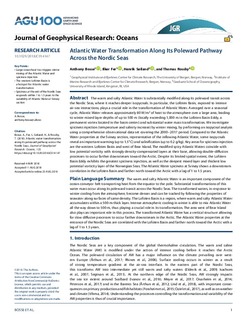| dc.description.abstract | The warm and salty Atlantic Water is substantially modified along its poleward transit across the Nordic Seas, where it reaches deeper isopycnals. In particular, the Lofoten Basin, exposed to intense air‐sea interactions, plays a crucial role in the transformation of Atlantic Water. Averaged over a seasonal cycle, Atlantic Water releases approximately 80 W/m2 of heat to the atmosphere over a large area, leading to winter mixed layer depths of up to 500 m (locally exceeding 1,000 m in the Lofoten Basin Eddy, a permanent vortex located in the basin center) and substantial water mass transformation. We investigate spiciness injection (temperature and salinity increase) by winter mixing, by performing an isopycnal analysis using a comprehensive observational data set covering the 2000–2017 period. Compared to the Atlantic Water properties at the Svinøy section, representative of the inflowing Atlantic Water, some isopycnals reveal an important warming (up to 1.5°C) and salinification (up to 0.2 g/kg). Key areas for spiciness injection are the western Lofoten Basin and west of Bear Island. The modified spicy Atlantic Waters coincide with low potential vorticity with strongly density‐compensated layers at their base, allowing double‐diffusion processes to occur farther downstream toward the Arctic. Despite its limited spatial extent, the Lofoten Basin Eddy exhibits the greatest spiciness injection, as well as the deepest mixed layer and thickest low potential vorticity layer of the Norwegian Seas. The Atlantic Water spiciness at Svinøy shows a downstream correlation in the Lofoten Basin and farther north toward the Arctic with a lag of 1 to 1.5 years. | nb_NO |
